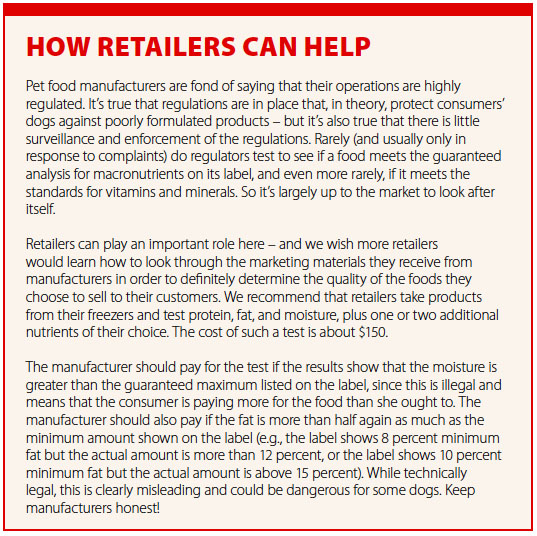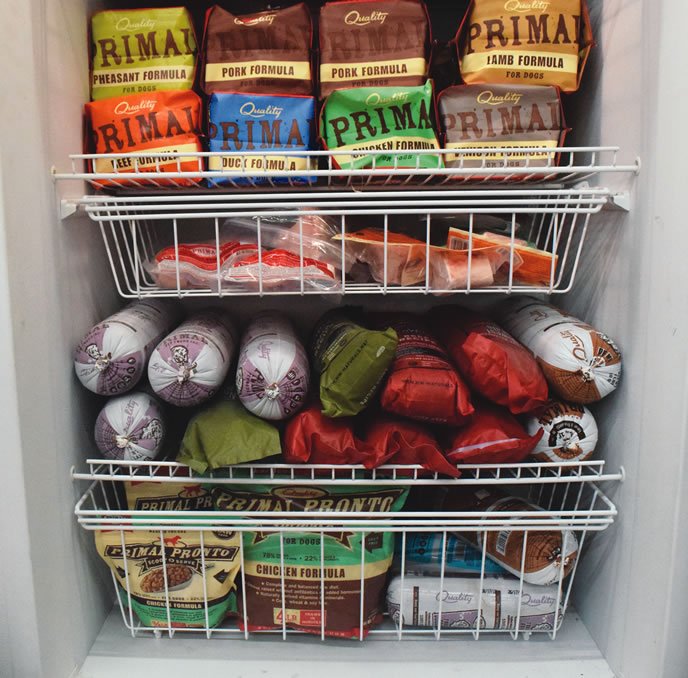Three of the most knowledgeable and experienced advocates of well-formulated raw diets for dogs have joined forces to explain how to evaluate commercial raw diets. We described them in the inaugural installment of this column last month: Dr. Karen Becker, a leading holistic veterinarian; Steve Brown, one of the founders of this industry; and Mary Straus, one of the most dedicated canine nutrition researchers and writers. This month, we’ve asked them to address the state of the commercial raw diet industry, starting with diets that are labeled as “complete and balanced” or “AAFCO-compliant” (formulated to meet the nutritional levels established by the Association of American Feed Control Officials).
Their executive summary? More and more dog owners and veterinarians are learning that well-formulated raw diets are the best food for most dogs most of the time – but the commercial raw dog food industry has problems. They are disappointed with the apparent lack of basic nutritional knowledge demonstrated by many companies – as evidenced by the formulation of their products – despite the manufacturers’ good intentions.
They hasten to add, however, that consumers can learn how to evaluate raw products and the companies that make them, in order to avoid the poorly formulated ones and buy the best products for their dogs. While consumers have no way to determine the quality of the ingredients used by the manufacturers, or whether they really include the ingredients listed on their product labels, owners can evaluate the companies’ formulation proficiency and how that impacts the nutritional adequacy of their products.
Following are six guidelines to help you evaluate commercial raw diets. – Nancy Kerns, Editor.
1. For puppies, make sure the food contains both calcium and phosphorus sources.
This is number one on Dr. Becker’s list of things that are most important for good health. Bone meal, dicalcium phosphate, tricalcium phosphate, or calcium hydroxyapatite must be added to boneless foods in order to meet American (AAFCO1), European (FEDIAF2), or ancestral growth guidelines for phosphorus. For adult maintenance, a calcium-only source is usually acceptable.
Puppies need more calcium and phosphorus than adult dogs do to support their growing bones. Both the total amounts of and the ratio between calcium and phosphorus are important in order to prevent growth abnormalities in large-breed puppies. Manufacturers must know how to provide proper calcium and phosphorus amounts and ratios for puppies if they claim their food meets AAFCO guidelines for growth or all life stages, yet many companies seem not to understand this critical point.
According to hundreds of simulations and tests that Steve has run with Mary’s confirmation, in order to meet AAFCO guidelines for growth, both calcium and phosphorus must be added to diets that do not contain bone (bone provides both calcium and phosphorus). Meat contains a fair amount of phosphorus, but even an all-meat diet does not provide sufficient phosphorus for growth stages.
Calcium-only supplements such as calcium carbonate, eggshell powder, coral calcium, and oyster shell powder will not suffice, as they do not provide the additional phosphorus required for proper growth.
In Table I, we list the amounts of calcium and phosphorus that are required by AAFCO for canine adult (“maintenance”) and puppy (“growth”) diets – and show how adding a calcium-only supplement to a bone-free recipe comprised of 80 percent low-fat meat and 20 percent vegetables – or even a recipe with all meat! – would fall short of meeting calcium and phosphorus standards for puppies. If you add enough calcium to meet the minimum required for growth, the ratio of calcium to phosphorus will exceed the maximum allowed, which can be particularly harmful to large-breed puppies.
TABLE I: Boneless Puppy Diets Need Added Phosphorus
| Guidelines (grams per 1,000 calories) | Calcium (Ca) | Phosphorus (P) | Ca : P Ratio |
|---|---|---|---|
| AAFCO 2014* adult maintenance requirement (minimum) | 1.25 | 1 | 1:1 to 2:1 |
| AAFCO 2014* growth and reproduction requirement (min) | 3 | 2.5 | 1:1 to 2:1 |
| Sample recipe with 80% meat, 20% veg, no added calcium | 0.1 | 1.1 | 0.1:1 |
| Same recipe with adequate calcium for growth added | 3 | 1.1 | 2.7:1 |
| All-meat recipe, same amount of calcium | 3.1 | 1.1 | 2.8:1 |
2. Look for foods that are formulated on a caloric basis, not dry matter.
We’re not going to sugar-coat this one: To determine whether or not a food has been properly formulated on a caloric basis is going to require some diligence on your part; it’s not something that will be easily found on a product label. You will have to contact the commercial raw food manufacturer and ask for a nutritional analysis of their product based on calories. In our opinion, if a manufacturer cannot provide you with this analysis or fails to respond to your request, they shouldn’t be trusted to provide your dog with complete and balanced nutrition.
The AAFCO Official Publication and the European equivalent, the FEDIAF Nutritional Guidelines, both list nutrient profiles in two different ways: by weight (dry matter, or DM) and by calories (kcal of metabolizable energy, or ME). For typical high-carbohydrate, lower-fat dry dog foods with low or moderate calories, a manufacturer can use DM profiles. For high-calorie foods, however, including essentially all commercial raw diets, manufacturers must use the profiles based on calorie content, or correct for energy density.
Raw diets are energy dense because even the leanest raw diets have a lot of fat compared to kibble. Fat has more than twice the calories per gram as protein and carbs do, so the more fat in a diet, the more calories. You therefore feed less (by weight) of higher-fat diets to provide the same number of calories, meaning your dog will get less of all the other nutrients in the diet unless those nutrients have been increased (corrected for energy density).
If a raw dog food company formulates on a dry matter basis (amounts per kilogram DM), rather than a caloric basis (amounts per 1,000 kcal), without correcting for energy density, the food will probably not meet AAFCO’s nutritional standards for complete and balanced pet food. Most of the raw diet companies willing to provide a nutritional analysis report on a DM basis, and their diets appear to be formulated to meet the AAFCO DM guidelines, without correcting for energy density.
To illustrate the sometimes big differences between using dry matter and caloric guidelines, we created a basic recipe, consisting of only meat (85 percent lean ground beef) with enough supplements added to balance the recipe on a dry matter basis. The recipe meets all AAFCO 2014* mineral recommendations for all life stages on a dry matter basis (see Table II). But on a caloric basis, this recipe falls well short of AAFCO minimums for every mineral, and provides only about two-thirds of the minimum recommended amount of calcium and phosphorus for growing puppies.
TABLE II: AAFCO 2014* All Life Stages
| Dry Matter Basis | Caloric Basis | |||||
|---|---|---|---|---|---|---|
| Nutrient | Units, DM basis | AAFCO 2014* DM required minimums | "Basic Recipe", DM | Units per 1,000 kcal | AAFCO 2014* required min. per 1,000 kcal | "Basis Recipe", per 1,000 kcal |
| Calcium (Ca) | % | 1.2% | 1.2% | g | 3.0 | 2.1 |
| Phosphorus (P) | % | 1.0% | 1.0% | g | 2.5 | 1.7 |
| Potassium (K) | % | 0.6% | 0.8% | g | 1.5 | 1.4 |
| Sodium (Na) | % | 0.3% | 0.3% | g | 0.8 | 0.6 |
| Magnesium (Mg) | % | 0.06% | 0.06% | g | 0.15 | 0.11 |
| Iron (Fe) | mg/kg | 88 | 91 | mg | 22 | 16 |
| Copper (Cu) | mg/kg | 124 | 129 | mg | 3.1 | 2.2 |
| Manganese (Mn) | mg/kg | 7.2 | 7.6 | mg | 1.8 | 1.3 |
| Zinc (Zn) | mg/kg | 100 | 124 | mg | 25 | 21 |
| Iodine (I) | mg/kg | 1 | 1.15 | mg | 0.25 | 0.2 |
| Selenium (Se) | mg/kg | 0.35 | 0.44 | mg | 0.09 | 0.08 |
3. Watch out for too much fat.
If a fresh (not freeze-dried or dehydrated) raw food that contains vegetables has more than 60 kcal/oz (960 kcal/lb or 2,116 kcal/kg), or a food without vegetables has more than 65 kcal/oz (1,040 kcal/lb or 2,293 kcal/kg), the fat content may exceed safe upper limits. If it’s a beef food, it may be short on tryptophan, and if poultry, it may have too much linoleic acid (LA), an omega-6 fatty acid that is considered to be pro-inflammatory at high levels. The food should be avoided.
Raw diets can be expensive to produce, so there’s an incentive for manufacturers to use less expensive high-fat meats, resulting in products that may not be a healthy choice for many dogs. Ideally, canine diets should have about twice as much protein as fat. We do not recommend ever feeding foods with more fat than protein.
Higher-fat foods have a greater likelihood of failing to meet every nutritional standard for a complete and balanced diet. Basing a diet on fatty meats can result in products that fall short of minimum recommended amounts of protein for puppies, exceed safe upper limits for total fat, and have poorly balanced fats. High-fat poultry diets may exceed AAFCO and FEDIAF maximums for LA.
Equally concerning are beef diets formulated on a base of 70 percent lean beef; such a diet fails to provide even half of the minimum recommendations for the essential amino acid tryptophan (some studies suggest that diets with inadequate tryptophan may lead to aggressive behaviors and contribute to anxiety disorders).
It’s difficult to know the real fat content of a food because fat is listed on the label as a guaranteed minimum amount, not the actual amount, which may be considerably higher. We’ve seen foods listing 8 percent fat on the label that, when tested, actually contained 18 percent fat. The best way to determine the fat content of a food is to check the number of calories in the food; high calories = high fat. This information is often on the website; if not, call the company to ask.
Nutrient standards aside, we’re concerned about people feeding their dogs diets with the consistently high fat content seen across the board in commercial raw products. For comparison, fresh raw foods with 60 to 65 calories per ounce would normally have about 50 percent fat on a dry matter basis (look at the freeze-dried versions to get a better idea of how much fat these products contain when moisture is removed). Compare that to kibble, where 20 percent fat is considered to be a high-fat diet; these foods contain more than twice as much fat!
Another way to look at the amount of fat in the diet is as a percentage of calories. Sled dogs, who work hard in cold temperatures and need more fat than just about any other dogs, are commonly fed diets where about 60 percent of calories come from fat. In comparison, raw diets with 60 to 65 calories per ounce typically derive more than 70 percent of their calories from fat!
Too much fat can lead to digestive upset and even pancreatitis in susceptible dogs, especially those switched suddenly from a diet much lower in fat. Feeding high-fat diets can also lead to obesity, or to nutritional deficiencies. The latter can occur if the dog is fed less in order to prevent weight gain, unless the manufacturer compensated for the high fat level (increased calories) by adding more nutrients. In other words, your dog still needs the same amount of vitamins and minerals each day, even if you have to reduce how much he is fed in order to provide an appropriate number of calories. Nutritional deficiencies are more likely to affect dogs who eat less than would be expected for their weight (including older and less active dogs).
4. Beware of foods containing beef liver and copper supplements.
In every recipe we’ve analyzed, there is no need to add a copper supplement to a recipe with beef liver, which is rich in copper (see Table III). In many cases, adding a copper supplement to a recipe that includes beef liver causes the diet to exceed the European legal limit for copper in dog food.
Why do companies add copper to diets containing beef liver? Because it’s easier and less expensive for a manufacturer to use just one supplement mix than to have various mixes for different products. They buy in greater volumes and therefore get lower costs. But in our opinion, there is no good reason for the larger raw diet manufacturers to use the same supplement mix for all of their products.
This is especially important for certain breeds of dogs that may have a genetic propensity toward copper toxicosis (CT) even when fed commercial dog food that meets AAFCO guidelines. CT is a particularly severe problem in Bedlington Terriers, but it has been recognized in up to 53 other breeds, including Dalmatians, Doberman Pinschers, Labrador Retrievers, Skye Terriers, and West Highland White Terriers, where pedigree studies have confirmed a hereditary cause. Recent findings indicate that other breeds may also be affected, including the Airedale Terrier, American Cocker Spaniel, Anatolian Shepherd, Beagle, Boxer, Cavalier King Charles Spaniel, German Shepherd, Keeshond, and Norfolk Terrier, as well as mixed-breed dogs. We’ll write more about this in a future issue.
In a seminar that Dr. Becker and Steve Brown conduct, they build two similar recipes, with one based on boneless beef and the other on bone-in poultry. See Table IV to compare the amounts of copper in each recipe before supplementation. They make the point that if they added the same amount of copper to both recipes to enable the chicken recipe to reach AAFCO minimum amounts for growth, they’d be very close to exceeding European legal limits for copper in the beef recipe.
Indeed, in our preparation work for this article, we found many beef diets that exceed FEDIAF legal limits for copper. As an example, one leading raw diet company produces several varieties of “complete and balanced” foods for “all life stages” using the same premix, with copper supplements, in all the foods. According to its own analyses, its chicken variety has either 2.6 or 5.4 mg copper per 1,000 calories (values provided vary between the frozen and freeze-dried versions, which should be identical), which may meet AAFCO minimum recommendations for growth, while its beef variety has about 29 mg copper per 1,000 calories, more than four times the European legal limit of 7.1 mg (again, see Table IV).
Looking at it another way, its chicken food has either 12 or 27 mg/kg DM of copper, meeting minimum recommended amounts of 9 mg/kg for adult dogs (after correcting for the calories in this food) and possibly meeting minimum recommended amounts for puppies of 15 mg/kg (after correction), while its beef food has about 160 mg/kg of copper, more than four times the European legal limit of 39 mg/kg DM (after correction).
TABLE III: Copper Amounts in Liver
| Type of liver | Copper mg/kg (as fed) |
|---|---|
| Chicken liver, raw | 5 |
| Turkey liver, raw | 9 |
| Beef liver, raw | 98 |
| Lamb liver, raw | 70 |
TABLE IV: Copper in Sample Chicken and Beef Recipes Before Supplementation
| AAFCO 2014* | FEDIAF | RECIPES | |||
|---|---|---|---|---|---|
| Adult (min) | Growth (min) | Legal limit (max) | Chicken | Beef | |
| Copper, mg/1,000 kcal | 1.8 | 3.1 | 7.1 | 1.1 | 4.5 |
| Copper, mg/kg DM | 7.3 | 12.4 | 28 | 5.5 | 25.2 |
5. Check the ingredients list for sources of manganese, iodine, and vitamin E.
Through years of analyses, the development of hundreds of recipes, and many more hundreds of simulations, Steve has found that it is very difficult to meet AAFCO’s minimum guidelines for iodine, manganese, and vitamin E without using supplements or including very specific foods. If one does not see specific foods or supplements for iodine, manganese, and vitamin E, the foods likely will not meet the definition of complete and balanced, and may not be healthy. Note that while some manufacturers claim that spirulina is a source of manganese and/or iodine in their foods, it’s not likely to provide enough to meet the recommended amounts.
Manganese
Manganese deficiency primarily affects puppies. Symptoms can include poor growth and skeletal abnormalities (shortening and bowing of the forelegs). In adults, it has been linked to lameness, enlarged joints, and ataxia (loss of balance). Manganese deficiency has also been reported to have profound negative effects on reproduction, and may contribute to cruciate ligament injuries.
Usually, raw food manufacturers need to add a manganese supplement in order to meet minimum manganese standards, unless they contain specific food sources of manganese. Organ meats (such as liver and kidney, but not heart) are rich in manganese, but to reach the required level of manganese with only these foods, you’d have to include so much that the diet would exceed maximums for vitamin A, and perhaps copper and other nutrients. The ancestral diet of dogs provided ample manganese from the small organs and glands found in whole prey, but these are impractical for manufacturers to source.
Look for a manganese source. Mussels and some species of clams are rich in manganese, but also expensive. Some spices, such as clove and ginger, are high in manganese, but large amounts would be needed to meet manganese standards, and the food may not be palatable. Whole grains are also high in manganese, as are leafy green and some other vegetables, berries, and legumes (beans). Adding 10 percent whole grains and 20 percent manganese-rich vegetables will enable a food to meet minimum requirements.

Iodine
Iodine is required by the body for many physiological processes, including healthy thyroid function. Consistently low intake of iodine can contribute to hypothyroidism and goiter (enlarged thyroid gland) in all breeds of dogs. Long-term deficiency can cause myxedema, which affects the skin, and skeletal deformities. Other signs of deficiency may include hair loss, lethargy, and fearfulness.
Look for specific sources of iodine. Some kelp products, but not all, are iodine-rich; the manufacturer needs to use specific brands to ensure proper amounts of iodine. Some manufacturers provide iodine with iodized salt, or a supplement such as Ethylenediamine Dihydriodide (EDDI).
Vitamin E
Vitamin E is an antioxidant that helps to protect the fats in your food and in your body from oxidizing (going rancid, creating free radicals that cause cell damage). Vitamin E is essential in keeping the cells of the muscles, heart, liver, and nerves alive and functioning. Long-term deficiency can lead to “brown bowel syndrome,” causing ulceration, bleeding, and degeneration of the intestines. The eyes can also be affected.
Look for specific sources of vitamin E (tocopherols) in the foods you feed. Unless the company uses a lot of of wheat germ oil, a vitamin E supplement should be included. The polyunsaturated fats in poultry and fish require more vitamin E protection than do the saturated fats in beef and bison foods.
6. If a company uses linear feeding directions, question the company’s competency.
If a company recommends that a 40-pound dog be fed twice as much as a 20-pound dog, or states “feed 2-3 percent of the dog’s body weight per day,” the company hasn’t studied basic nutrition or paid attention to the feeding directions done by professionals. Their foods may still be good, but it’s not a good sign that they don’t understand the basic energy requirements of dogs.
There are many different formulas for calculating energy needs, but they all rely on one simple fact: large dogs need fewer calories per pound of body weight than do small dogs. An active 10-pound dog on a lean diet may require 8 percent of her body weight or more per day, while a moderately active 110-pound dog eating a fattier diet may require less than one percent of her body weight per day.
Feeding directions are meant to be a starting point for determining each individual dog’s needs; people should feed whatever amount is needed to keep their dogs at a proper weight. But the use of linear feeding directions (e.g., showing double the amount of food for double the amount of weight) shows that the manufacturer has not done its homework – and is passing along an over-casual recommendation to its consumers.
In our survey, we found that fewer than one-third of raw food companies use appropriate, non-linear feeding directions, while 100 percent of the companies that make dry food use proper feeding directions.
Conclusions
The commercial raw pet food industry is growing rapidly, providing dozens of brands to choose from, ranging from excellent to poor quality. Through our research we have found well-intentioned companies that want to formulate correctly, but it appears they just don’t know how. We have also found companies whose principals know their products don’t meet these important guidelines and don’t seem to care. It’s up to owners to check and confirm that the makers of their dogs’ food are doing things right. These guidelines will help you make the best decisions about what commercial raw foods to feed – or may expedite a transition onto a homemade diet. Future articles in this series will show you how!
In the meantime, there are some great raw diets on the market. If you follow these guidelines, you’ll be able to find them. (We are hesitant to name companies in this series because Dr. Becker and Steve provide consultation services for several of them, and we want to avoid conflicts of interest.)
Feed a variety of different brands using different protein sources to help make up for what may be missing or excessive in any individual product. Nutritional deficiencies and imbalances don’t make a food dangerous per se, particularly if it’s used as only part of a varied diet. The danger is much greater for dogs fed only one brand or type of food continuously.
If you must feed one brand exclusively, or if you’re feeding a growing puppy or pregnant or nursing female, choose a company that is willing and able to provide you with a full nutritional analysis done on a caloric basis, ideally compared to the AAFCO standards.
Consumers can play an important role in making the commercial raw diet industry better. All you need do is question the manufacturers and ask to see their nutritional analyses. When you buy commercial raw diets, you are spending a lot of money and deserve and have the right to ask detailed questions. The more you question, the better the products will become and the better dogs will be fed.
We hope companies will use these guidelines to make improvements and corrections with their products, if needed. The fact that only about a third of the raw food companies have correct feeding instructions should be concerning to everyone. Put pressure on the companies to do it right, and you’ll help your dogs and many others.






great article, but I’m not seeing the charts or tables that you refer to
Ariel, the tables got lost when some maintenance was done to this site. They should be fixing it soon.
So, Lets have the brand names already. Which raw commercial brands meet the criteria listed above, which meet it partially and which fall short. I hope the authors of this article are able to understand that less than 1%, maybe less than 0.1% of dog owners have the chemistry degree and the time to calculate copper requirements for each day, each meal, each bite. Seriously, I have a Ph.D in biochemistry from U.C. Berkeley and I am not able to properly evaluate the labels of Small Batch brand commercial raw vs. Primal and I am much less able to formulate my own raw food for my new puppy. My veterinarian wants me to feed puppy formula kibble and, to be quite honest, I don’t trust myself to get the calcium, phosphorus, magnesium and manganese ratios correct compared to say Purina.
Don’t get me wrong, I appreciate this article but without naming brands and getting specific in the practicalities (vs. the chemistry) this article is not helpful.
Susan, there is only one brand of commercial raw food that I’m aware of that meets AAFCO guidelines. I don’t want to name the brand, but if you contact the companies you’re interested in, this one will be happy to provide you with a complete nutritional analysis showing that their foods meet those guidelines on a caloric basis (not DM, which must be adjusted based on the amount of fat in the food before it can be compared to AAFCO guidelines). It is not one of the brands you named, neither of which I would trust to feed to a puppy, particularly a large-breed puppy under the age of six months, when nutritional deficiencies and excesses can cause the most harm.
You should not have to make calculations yourself. If the company you’re interested in has not done them for you, then you should assume that their foods will not meet the appropriate criteria.
There are additional choices beyond kibble and raw, including cooked foods, such as those from Just Food For Dogs, and dehydrated foods, such as those from The Honest Kitchen. As long as you choose varieties approved for puppies or for all life stages, these foods could be better choices for your pup than kibble.
I want to also say that Mary Strauss’ website, DogAware.com saved the life of my miniature poodle pup 14 years ago. She suffered from terrible GI issues (probably from being weaned too early and/or having a very bad case of Giardia and needing multiple rounds of meds to cure her). I had to map out all her food allergies that no doubt arose from disbiosis and heal her GI tract and bring her back to health. The veterinary field offered no help to me except for Hills Science diet and prednisone. Mary’s articles and insight was invaluable and I am eternally grateful to her. The experience I had with this pup and Mary’s site opened my eyes to nutrition for dogs and dramatically improved my pet’s lives and also gave me the knowledge to feed myself better. Thank You!
Thank you for this helpful analysis and information. With the guidance of a natural pet food store owner who has been researching pet food for decades, we are currently using a mix of a third each of kibble (Acana Wholesome Grains), wet canned food (typically Evanger’s), and raw food (K-9). It seems to be working well for our female boxer.